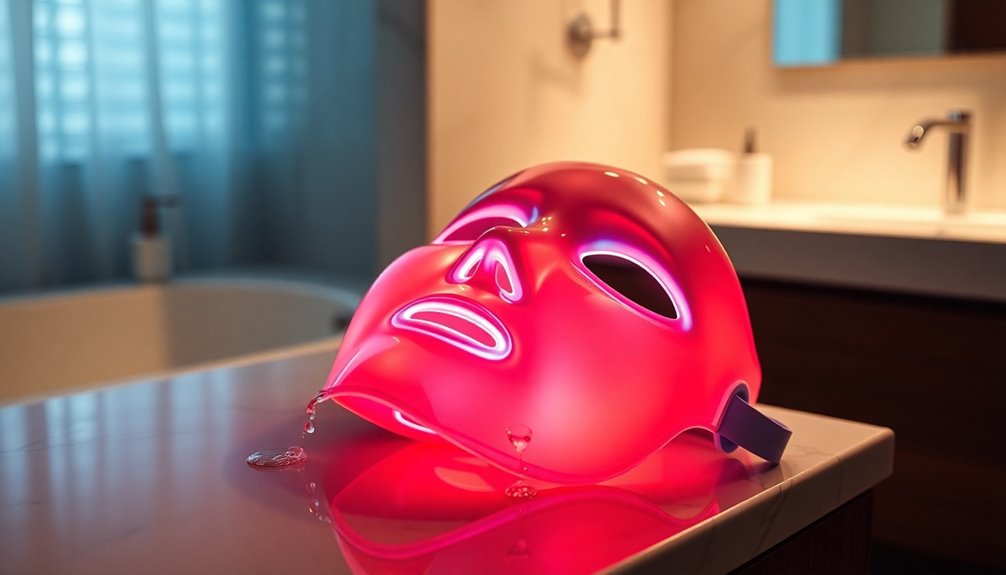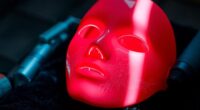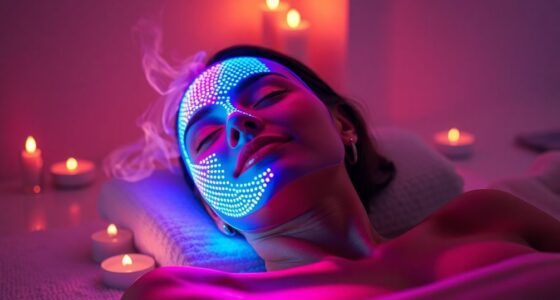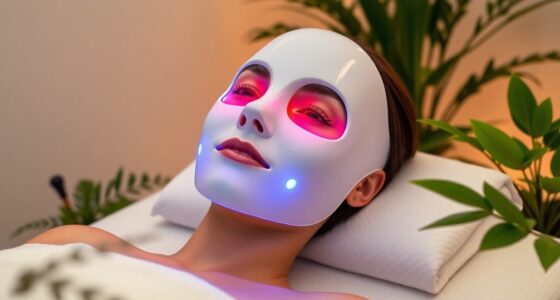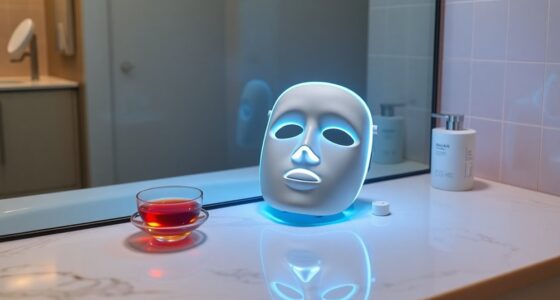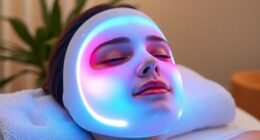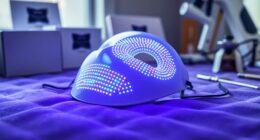LED face masks are a powerful skincare tool that provides impressive benefits through light therapy. They effectively target various concerns, like acne, fine lines, and uneven skin tone. With consistent use, you’ll likely see improvements in texture and reduced inflammation. While results can vary, many users report significant enhancements in their skin’s appearance. If you want to learn about the different types of light and how to use these masks for the best results, there’s more to explore!
Key Takeaways
- LED face masks offer non-invasive skin enhancement through light therapy, targeting various concerns like fine lines and acne.
- Regular use of LED masks (3-5 times a week) can lead to noticeable improvements in skin texture and overall appearance.
- Different light wavelengths provide specific benefits: red for collagen production, blue for acne, and near-infrared for deeper healing.
- Users report reduced inflammation, quicker healing of breakouts, and modest anti-aging effects after consistent use.
- While effective, at-home LED masks may not match professional treatments; consultations with dermatologists are recommended for safety and optimal results.
What Are LED Face Masks?
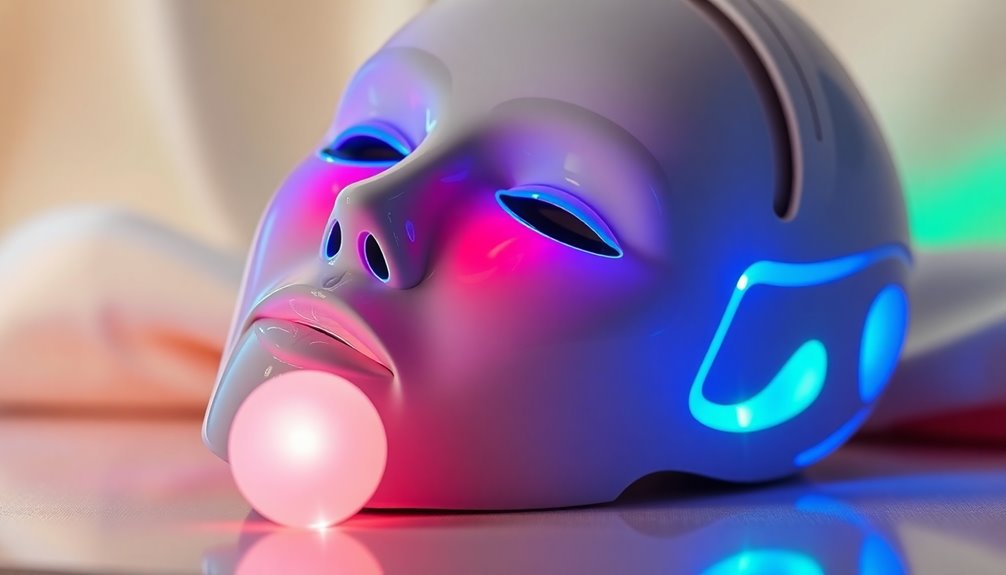
LED face masks are innovative skincare devices that harness the power of light therapy to enhance your skin’s appearance.
These LED masks utilize different wavelengths, specifically red and blue light therapy, to deliver various skin benefits. Red light therapy targets fine lines and wrinkles, boosting collagen production for a youthful glow. On the other hand, blue light therapy effectively reduces acne-causing bacteria, helping to clear your skin.
Designed for at-home treatment, these masks offer a non-invasive alternative to traditional dermatological procedures. Typically FDA cleared, they guarantee safety and effectiveness.
You’ll need to use them consistently—ranging from three to twenty minutes per session—to see visible results. Prices vary, making it easy to find a mask that fits your budget.
How Do LED Face Masks Work?
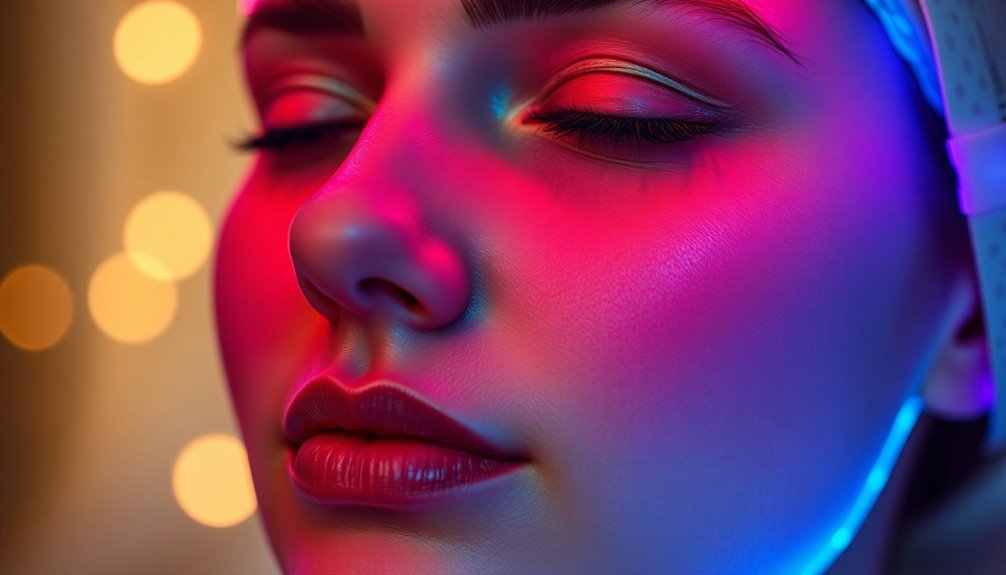
These innovative face masks use specific wavelengths of light to penetrate your skin and stimulate key biochemical reactions.
LED light therapy employs red and blue light, promoting collagen production and improving skin texture. Red light, with wavelengths from 630 to 660 nanometers, targets anti-aging by enhancing collagen and elastin.
Conversely, blue light operates between 405 to 420 nanometers, effectively tackling acne-causing bacteria, regulating oil production, and reducing breakouts.
Additionally, near-infrared light penetrates deeper skin layers (800 to 1,400 nanometers) to promote healing without overheating your skin.
For ideal results, it’s recommended to use LED masks for 5-20 minutes daily, allowing cumulative effects that lead to visible improvements in your skin over time.
Benefits of LED Face Masks
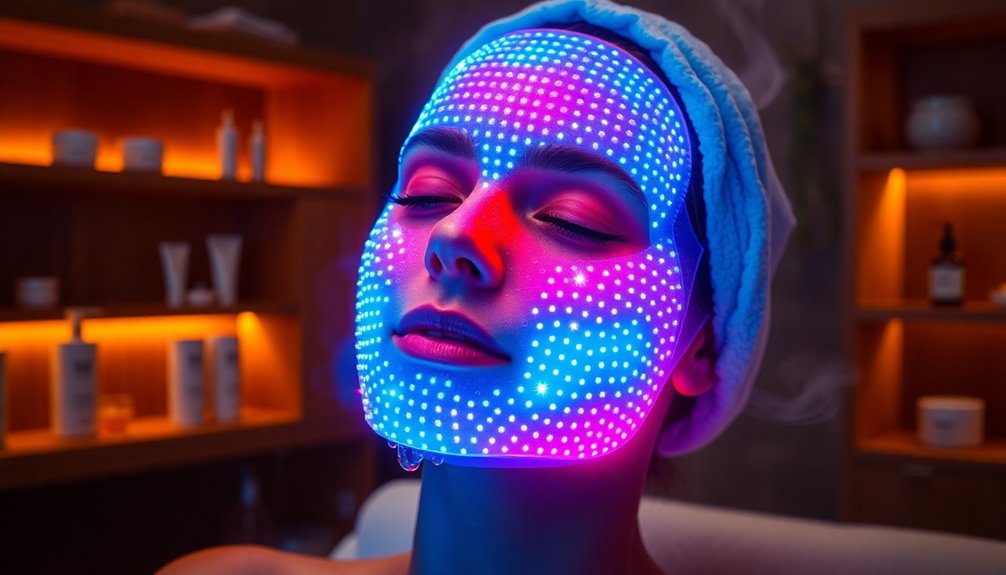
LED face masks offer impressive skin rejuvenation effects, helping you reduce fine lines and improve texture.
Plus, if you’re struggling with acne, these masks can target the bacteria responsible for breakouts.
With regular use, you can expect noticeable improvements in your skin’s overall appearance.
Skin Rejuvenation Effects
While exploring effective skincare options, you might find that LED face masks offer impressive skin rejuvenation effects.
These masks utilize LED light therapy to enhance collagen production and reduce inflammation, providing noticeable anti-aging benefits. Regular use, typically three to five times a week, can improve your skin’s glow and diminish fine lines and wrinkles over time.
Clinical studies show that red light therapy stimulates collagen synthesis, while blue light effectively targets acne-causing bacteria, leading to clearer skin. Users often report cumulative benefits, like faster healing of acne lesions and reduced scarring, within four to six weeks.
With many LED masks being FDA approved, you can feel confident in their safety and efficacy for non-invasive skin rejuvenation.
Acne Treatment Benefits
When it comes to tackling acne, many find that LED face masks, especially those featuring blue light therapy, can be game changers. This technology effectively targets and kills acne-causing bacteria, leading to fewer breakouts and improved skin clarity.
Blue light wavelengths (405 to 420 nanometers) reduce sebaceous gland activity, decreasing oil production and minimizing clogged pores. With consistent use, you can experience cumulative benefits, including reduced inflammation and quicker healing of acne lesions over several weeks.
Clinical studies show that users often see a decrease in acne lesions within 8 to 12 weeks. Additionally, LED face masks promote blood circulation, helping to alleviate redness and irritation associated with active acne, making them a valuable tool in your acne treatment arsenal. Furthermore, essential oils can complement LED therapy by providing additional relaxation and stress relief, which may further enhance skin health.
Types of Light and Their Effects
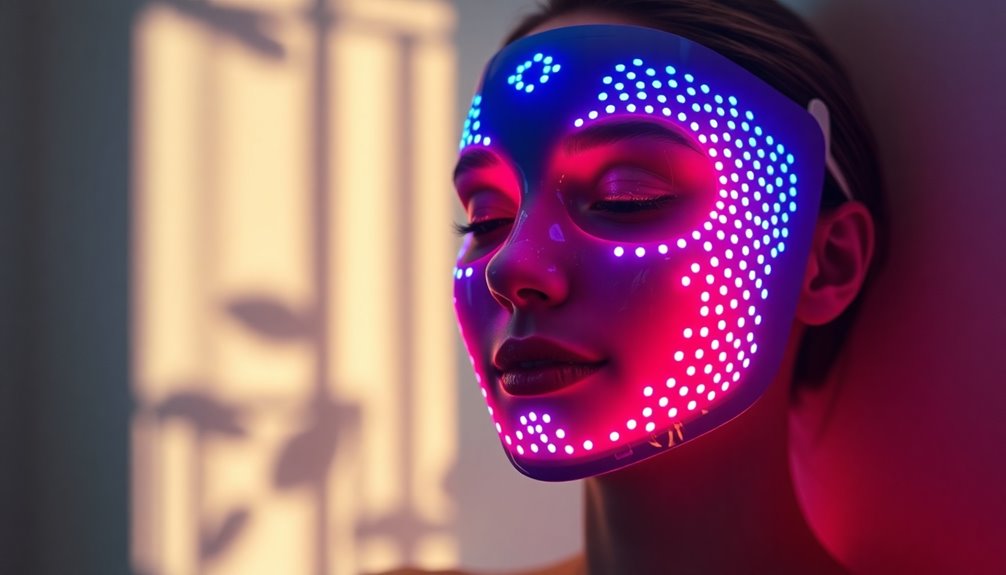
Different types of light in LED face masks offer unique benefits for your skin. Here are four key types to evaluate:
- Red Light: Wavelengths from 630 to 660 nm stimulate collagen production, reducing fine lines and improving skin texture.
- Blue Light: Operating at 405 to 420 nm, blue light targets acne-causing bacteria, helping to reduce inflammation and regulate oil production.
- Near-Infrared Light: With wavelengths from 800 to 1,400 nm, it penetrates deeper layers, enhancing collagen synthesis and cell turnover.
- Green Light: Ranging from 520 to 550 nm, this light helps reduce pigmentation and brightens skin, addressing uneven skin tone.
Do LED Face Masks Really Work?
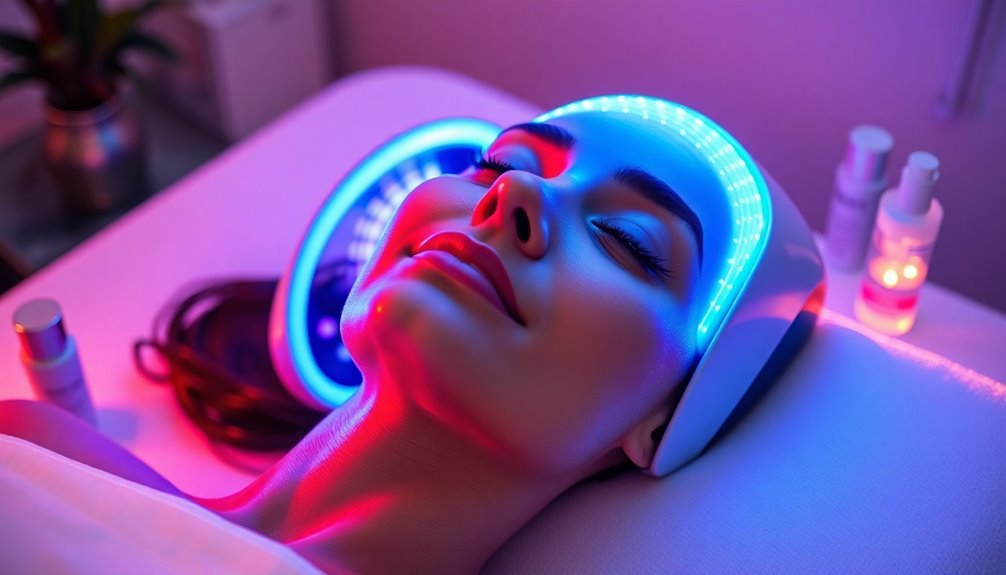
LED face masks have gained popularity for their potential skin benefits, but you might wonder how effective they really are.
These devices use specific wavelengths like red and blue light to promote biochemical reactions in your skin. Red light therapy is known for boosting collagen production and improving texture, while blue light therapy targets acne by reducing bacteria.
Clinical studies indicate that consistent use of LED masks can lead to subtle improvements, typically seen after four to six weeks of your skincare routine. While results may not match professional treatments, many users notice positive changes over time.
Just remember, individual results can vary, so it’s wise to consult a dermatologist before diving into LED masks.
Safety and Side Effects of LED Face Masks
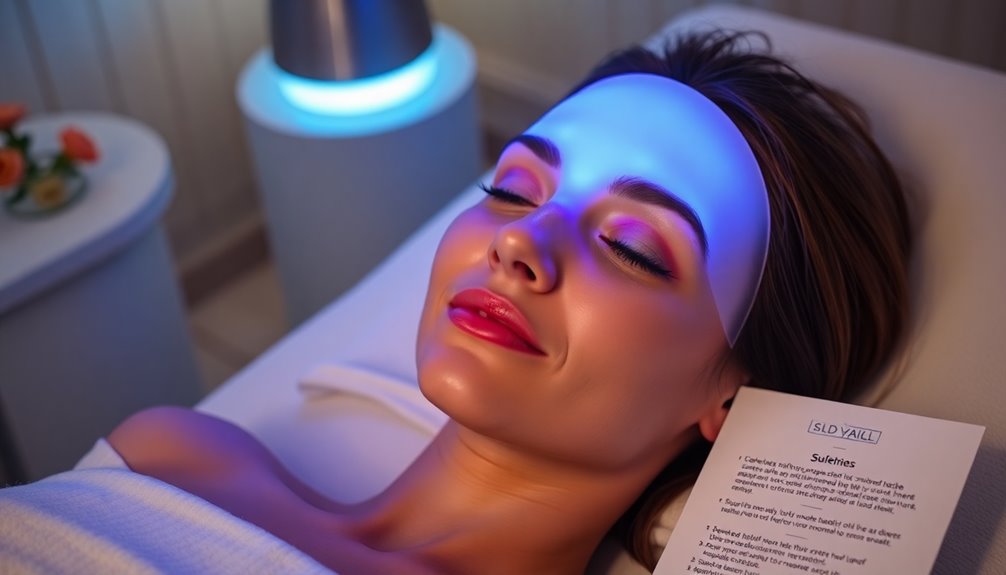
When using LED face masks, it’s important to take into account safety precautions, especially if you have light sensitivity.
You should always protect your eyes during blue light therapy sessions to avoid potential harm.
Remember that overuse can lead to irritation and redness, so sticking to the manufacturer’s guidelines is essential for a safe experience.
General Safety Considerations
Although LED face masks are generally safe for most users, it’s crucial to take into account individual sensitivities and potential side effects.
Here are some general safety considerations:
- Light Sensitivity: If you have light sensitivity, consult a dermatologist before use.
- Eye Protection: Always use eye protection, especially when using blue light, to prevent eye damage.
- Manufacturer Guidelines: Follow manufacturer guidelines closely to avoid misuse and guarantee safety.
- Skin Response: Monitor your skin’s response throughout treatment, as irritation or redness may occur if overused.
Possible Side Effects
While using LED face masks can offer various skin benefits, it’s important to be aware of possible side effects that may arise.
Although LED masks are generally safe to use, individuals with light sensitivity should consult a dermatologist before starting treatment. You might experience mild irritation, redness, or even increased inflammation, especially if you overuse the device or don’t follow manufacturer guidelines.
Eye protection is vital, particularly during blue light therapy, to safeguard your eyes from potential harm.
Remember that not all skin types respond the same way; some users might feel discomfort or see less-than-ideal results. It’s essential to assess your skin type and adjust usage accordingly to guarantee a positive experience.
How to Use LED Face Masks Effectively
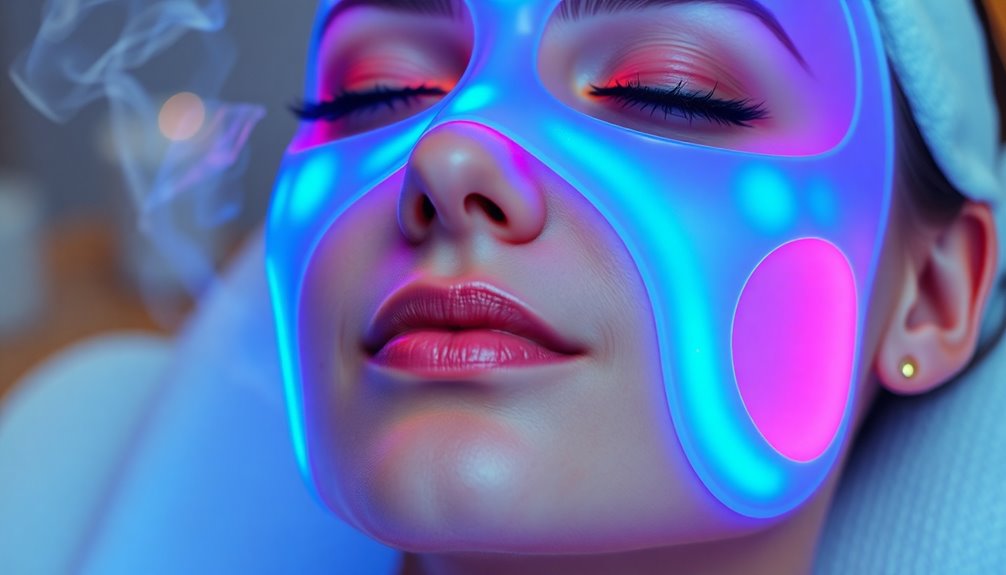
To get the most out of your LED face mask, start by cleansing and drying your skin thoroughly. This guarantees maximum absorption of the light therapy benefits.
Follow these steps for effective use:
- Apply the LED mask for the recommended duration, typically 3 to 20 minutes, depending on the device.
- Use it consistently at least three to five times a week to see significant results for your skin concerns.
- Shield your eyes during treatment, especially with blue light therapy, to prevent discomfort.
- After treatment, apply hydrating skincare products like serums and moisturizers to enhance recovery and maintain moisture.
Keep track of your progress by documenting changes with photos after a month of consistent use.
My Personal Experience With LED Face Masks

When I first incorporated the Dr. Dennis Gross LED mask into my skincare routine, I noticed significant changes.
After using it 4-5 times a week, my skin texture improved, and inflammation reduced within a month. The three-minute daily sessions fit seamlessly into my life—I could even catch up on TV while treating my skin.
With consistent use, I saw a reduction in the size and redness of cystic acne around my chin, along with quicker healing times for breakouts.
While the anti-aging benefits were modest, like reduced puffiness, they were still noticeable.
Choosing the Right LED Face Mask for You
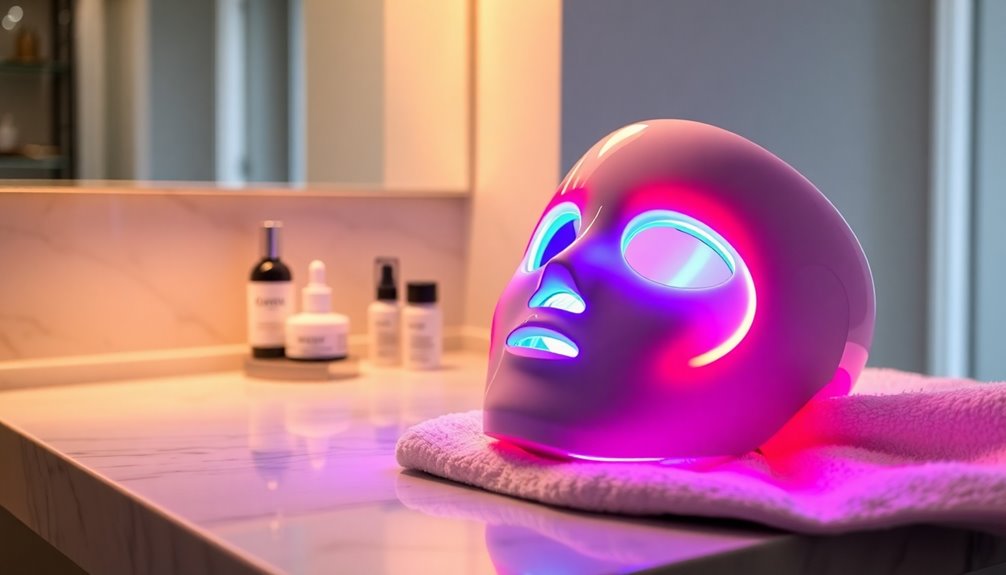
When you’re picking an LED face mask, it’s crucial to take into account your skin type and specific light therapy benefits.
Different wavelengths target various skin concerns, so knowing your unique needs can help you find the right fit.
Skin Type Considerations
Choosing the right LED face mask for your skin type can greatly enhance your skincare routine. Here are some considerations to keep in mind:
- Sensitive Skin: Opt for masks with gentle wavelengths to avoid irritation.
- Dry Skin: Look for LED masks that promote hydration, possibly with red light therapy to boost collagen production.
- Oily or Acne-Prone Skin: Blue light therapy is ideal for targeting acne-causing bacteria and reducing inflammation.
- Combination Skin: Consider masks like the Dr. Dennis Gross SpectraLite FaceWare Pro, which offers both red and blue light for a thorough approach.
Always consult with a dermatologist’s office to tailor your choice of LED masks to your specific skin types and concerns, ensuring safe and effective results.
Light Therapy Benefits
Understanding how light therapy benefits your skin can help you make an informed decision about which LED face mask suits your needs. LED masks utilize specific light wavelengths, promoting collagen production and targeting acne-causing bacteria. Consistent use, typically three to five times a week, can lead to visible improvements in skin texture and inflammation after four to six weeks.
| Light Color | Benefits | Recommended Use |
|---|---|---|
| Red | Increases collagen production | 3-5 times a week |
| Blue | Targets acne-causing bacteria | 3-5 times a week |
| Green | Reduces pigmentation | 1-2 times a week |
Choosing the right mask, considering quality and features, is essential for enhancing your skincare routine effectively.
Expert Opinions on LED Face Masks

How effective are LED face masks in improving skin health? Experts, including board-certified dermatologists, suggest that consistent use can lead to subtle improvements in skin texture and wrinkles.
Here’s what you should know:
- Red light therapy enhances collagen production, potentially improving skin elasticity.
- Blue light therapy targets acne-causing bacteria, helping to clear breakouts.
- Daily use of at least three minutes, three times a week, is recommended for visible benefits.
- A consultation with a dermatologist is essential to guarantee safety, especially for specific skin concerns.
While popular options like the Dr. Dennis Gross LED mask receive high ratings, remember that at-home devices mightn’t be as effective as professional treatments.
Always weigh financial considerations against the uncertain outcomes.
Frequently Asked Questions
Do LED Face Masks Really Work?
Do LED face masks really work? Yes, they can, but results vary.
You’ll find that red light boosts collagen production while blue light helps combat acne. Consistent use—about 5-20 minutes daily—can enhance your skin’s texture and reduce wrinkles.
However, keep in mind that at-home devices may not be as effective as professional treatments. It’s wise to consult a dermatologist to determine the best approach for your individual skin needs.
What Are the Disadvantages of a LED Mask?
Imagine standing in front of a mirror, hoping for radiant skin, but you might encounter some downsides with LED masks.
They can be pricey, with effectiveness often less than professional treatments. If you have sensitive skin, overuse might lead to irritation or redness.
Plus, results can be slow to appear, requiring patience.
Finally, the long-term safety of these devices isn’t fully understood, so it’s wise to proceed with caution.
What Does the Mayo Clinic Say About Red Light Therapy?
The Mayo Clinic suggests that red light therapy can enhance your skin’s tone and texture by boosting collagen production and reducing inflammation.
It’s generally safe for most skin types, but following the manufacturer’s instructions is essential. If you have concerns, consulting a dermatologist is wise.
While some studies show effectiveness, the clinic notes that more rigorous research is needed to confirm long-term benefits and ideal usage for best results.
Do Dermatologists Recommend Red Light Masks?
Yes, dermatologists often recommend red light masks for their potential skin benefits.
They can stimulate collagen production, helping reduce fine lines and improve skin texture. You might notice results after consistent use over four to six weeks.
However, experts emphasize that while these masks can complement your routine, they’re not a substitute for professional treatments.
Always consult with a dermatologist first to ascertain safety and effectiveness for your specific skin concerns.
Conclusion
In the world of skincare, LED face masks are like a light switch for your complexion, illuminating your path to healthier skin. With their various benefits, from reducing acne to enhancing collagen production, these masks can be a game-changer in your beauty routine. Just remember to choose the right one for your needs, and you’ll be well on your way to glowing, radiant skin. So, why not shine a little light on your self-care journey?
